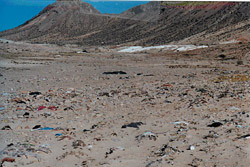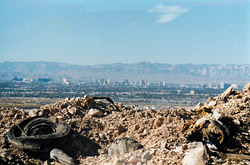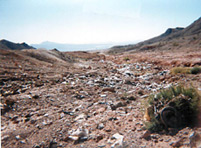Pacific Southwest, Region 9
Serving: Arizona, California, Hawaii, Nevada, Pacific Islands, Tribal Nations
Sunrise Landfill Construction Complete:
Protecting a Vital Drinking Water Source
Information and Resources
Contact Information
Steve Wall (Wall.Steve@epa.com)
(415) 972-3381
History
Sunrise Landfill received 18 million tons of the Las Vegas area’s municipal solid waste from 1953 until 1993, when the landfill stopped receiving waste. A major rainstorm in September 1998 swept through the landfill site, resulting in 100,000 cubic yards of waste being released to Las Vegas Wash and beyond. The Las Vegas Wash, which flows into Lake Mead, is the area’s main source of drinking water. The Phoenix area and parts of Southern California also rely on drinking water from Lake Mead.
Sunrise Mountain Landfill is unlined and contains mostly municipal solid waste, but also medical waste, sewage sludge, hydrocarbon-contaminated soils, asbestos, and construction waste.
Large-scale construction work has been completed to properly close the 440-acre Sunrise Mountain Landfill just outside Las Vegas. EPA required this work to ensure the resiliency of the final landfill cover and to protect a vital drinking water source for communities from Las Vegas to Phoenix to Southern California. This $36 million project includes new erosion and stormwater controls, a new cover system, landfill gas and groundwater monitoring systems, and a long-term maintenance and management program. These technically advanced controls secure the landfill and minimize the risk to Clark County residents from polluted water runoff and waste discharges.
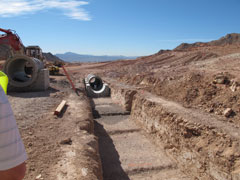
The innovative erosion-resistant cover of the landfill is a model for other desert landfill sites needing similar protections from erosion and water infiltration. The cover uses a unique soil and gravel mixture to armor the cover, control erosion, and secure the waste. The EPA-approved remedy ensures effective control of the landfill with a durable cover and stormwater system that addresses the unique geographic and climatic characteristics of Nevada’s arid desert landscape. A groundwater and landfill gas monitoring system was installed with 41 groundwater wells for quarterly sampling and 30 landfill gas probes for perimeter monitoring of the landfill.

More than one million cubic yards of soil and rock were excavated and placed in the site over the course of the project. To protect public health and the environment, EPA required the use of clean diesel construction equipment. Use of this technology protected Las Vegas residents from air pollution during construction, an important factor as diesel exhaust can reduce people’s lung capacity, aggravate asthma, and is a probable human carcinogen.
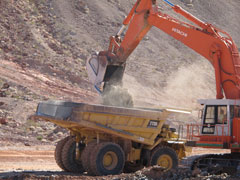
Construction work was completed under the terms of an EPA consent decree between Republic Services, operator of the site, Clark County, the BLM and EPA. Republic hired Las Vegas Paving Co. as the construction contractor, who employed 40 local workers for this project. The current construction is the last major field work to complete requirements of the consent decree and completes EPA’s efforts to properly close the landfill. The Bureau of Land Management and Clark County were also key partners in seeing this project to completion.
EPA will continue to work with Clark County and the Las Vegas business community to reduce materials ending up in landfills. Sustainable materials management can reduce the environmental impacts of widely-used everyday items over their entire life cycle, including how they are extracted, manufactured, distributed, used, reused, recycled, and disposed.
Views of Sunrise Landfill After the 1998 Storm

